
Marine biology is the scientific study of the biology of marine life, organisms in the sea. Given that in biology many phyla, families and genera have some species that live in the sea and others that live on land, marine biology classifies species based on the environment rather than on taxonomy.

Plankton are the diverse collection of organisms found in water that are unable to propel themselves against a current. The individual organisms constituting plankton are called plankters. In the ocean, they provide a crucial source of food to many small and large aquatic organisms, such as bivalves, fish and whales.
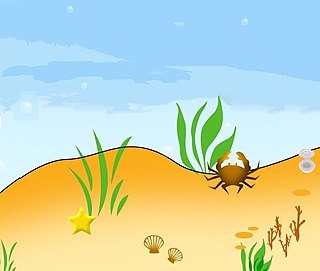
Benthos, also known as benthon, is the community of organisms that live on, in, or near the bottom of a sea, river, lake, or stream, also known as the benthic zone. This community lives in or near marine or freshwater sedimentary environments, from tidal pools along the foreshore, out to the continental shelf, and then down to the abyssal depths.

Amphipoda is an order of malacostracan crustaceans with no carapace and generally with laterally compressed bodies. Amphipods range in size from 1 to 340 millimetres and are mostly detritivores or scavengers. There are more than 9,900 amphipod species so far described. They are mostly marine animals, but are found in almost all aquatic environments. Some 1,900 species live in fresh water, and the order also includes the terrestrial sandhoppers such as Talitrus saltator.
The pelagic zone consists of the water column of the open ocean, and can be further divided into regions by depth, as illustrated on the right. The word pelagic is derived from Ancient Greek πέλαγος (pélagos) 'open sea'. The pelagic zone can be thought of as an imaginary cylinder or water column between the surface of the sea and the bottom. Conditions in the water column change with depth: pressure increases; temperature and light decrease; salinity, oxygen, micronutrients all change.

Aequorea victoria, also sometimes called the crystal jelly, is a bioluminescent hydrozoan jellyfish, or hydromedusa, that is found off the west coast of North America.

Sargassum is a genus of brown macroalgae (seaweed) in the order Fucales. Numerous species are distributed throughout the temperate and tropical oceans of the world, where they generally inhabit shallow water and coral reefs, and the genus is widely known for its planktonic (free-floating) species. Most species within the class Phaeophyceae are predominantly cold-water organisms that benefit from nutrients upwelling, but the genus Sargassum appears to be an exception. Any number of the normally benthic species may take on a planktonic, often pelagic existence after being removed from reefs during rough weather; however, two species have become holopelagic—reproducing vegetatively and never attaching to the seafloor during their lifecycles. The Atlantic Ocean's Sargasso Sea was named after the algae, as it hosts a large amount of Sargassum.
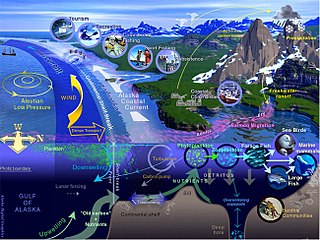
Marine life, sea life, or ocean life is the plants, animals and other organisms that live in the salt water of the sea or ocean, or the brackish water of coastal estuaries. At a fundamental level, marine life affects the nature of the planet. Marine organisms, mostly microorganisms, produce oxygen and sequester carbon. Marine life in part shape and protect shorelines, and some marine organisms even help create new land. Most life forms evolved initially in marine habitats. By volume, oceans provide about 90% of the living space on the planet. The earliest vertebrates appeared in the form of fish, which live exclusively in water. Some of these evolved into amphibians, which spend portions of their lives in water and portions on land. One group of amphibians evolved into reptiles and mammals and a few subsets of each returned to the ocean as sea snakes, sea turtles, seals, manatees, and whales. Plant forms such as kelp and other algae grow in the water and are the basis for some underwater ecosystems. Plankton forms the general foundation of the ocean food chain, particularly phytoplankton which are key primary producers.

Marine ecosystems are the largest of Earth's aquatic ecosystems and exist in waters that have a high salt content. These systems contrast with freshwater ecosystems, which have a lower salt content. Marine waters cover more than 70% of the surface of the Earth and account for more than 97% of Earth's water supply and 90% of habitable space on Earth. Seawater has an average salinity of 35 parts per thousand of water. Actual salinity varies among different marine ecosystems. Marine ecosystems can be divided into many zones depending upon water depth and shoreline features. The oceanic zone is the vast open part of the ocean where animals such as whales, sharks, and tuna live. The benthic zone consists of substrates below water where many invertebrates live. The intertidal zone is the area between high and low tides. Other near-shore (neritic) zones can include mudflats, seagrass meadows, mangroves, rocky intertidal systems, salt marshes, coral reefs, lagoons. In the deep water, hydrothermal vents may occur where chemosynthetic sulfur bacteria form the base of the food web.

Phronima sedentaria is a species of amphipod crustaceans found in oceans at a depth of up to 1 km (0.6 mi). They are large in size relative to other members of the family Phronimidae. Individuals may be found inside barrel-like homes, created most commonly from the tunics of select species of tunicate, where they rear their young. P. sedentaria is known to employ multiple feeding strategies and other interesting behaviors, including daily vertical migration. The species is also known by the more common names “pram bug” and “barrel shrimp.”

In zoology, deep-sea gigantism is the tendency for species of invertebrates and other deep-sea dwelling animals to be larger than their shallower-water relatives across a large taxonomic range. Proposed explanations for this type of gigantism include colder temperature, food scarcity, reduced predation pressure and increased dissolved oxygen concentrations in the deep sea. The inaccessibility of abyssal habitats has hindered the study of this topic.

Marine habitats are habitats that support marine life. Marine life depends in some way on the saltwater that is in the sea. A habitat is an ecological or environmental area inhabited by one or more living species. The marine environment supports many kinds of these habitats. Marine habitats can be divided into coastal and open ocean habitats. Coastal habitats are found in the area that extends from as far as the tide comes in on the shoreline out to the edge of the continental shelf. Most marine life is found in coastal habitats, even though the shelf area occupies only seven percent of the total ocean area. Open ocean habitats are found in the deep ocean beyond the edge of the continental shelf.
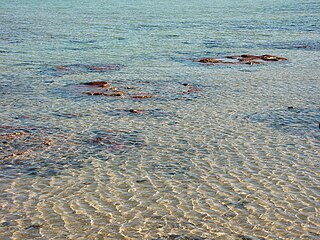
Shallow water marine environment refers to the area between the shore and deeper water, such as a reef wall or a shelf break. This environment is characterized by oceanic, geological and biological conditions, as described below. The water in this environment is shallow and clear, allowing the formation of different sedimentary structures, carbonate rocks, coral reefs, and allowing certain organisms to survive and become fossils.
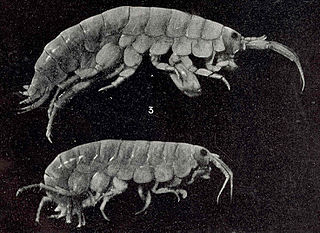
Platorchestia platensis is a species of sand flea, an amphipod crustacean that lives on beaches.

Mertensia ovum, also known as the Arctic comb jelly or sea nut, is a cydippid comb jelly or ctenophore first described as Beroe ovum by Johan Christian Fabricius in 1780. Unusually among ctenophores, which normally prefer warmer waters, it is found in the Arctic and adjacent polar seas, mostly in surface waters down to 50 metres (160 ft).
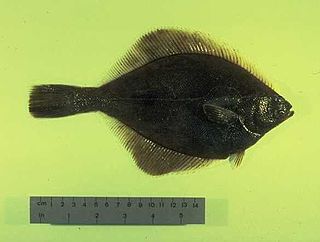
The yellowfin sole is a flatfish of the family Pleuronectidae. It is a demersal fish that lives on soft, sandy bottoms at depths of up to 700 metres (2,300 ft), though it is most commonly found at depths of around 91 metres (299 ft). Its native habitat is the temperate waters of the northern Pacific, from Korea and the Sea of Japan to the Sea of Okhotsk, the Bering Sea and Barkley Sound on the west coast of Canada. Males grow up to 49 cm (19 in) in length, though the common length is around 33.5 cm (13.2 in). The maximum recorded weight is 1.7 kg (3.7 lb), and the maximum recorded lifespan is 26 years.

Metridium senile, or frilled anemone, is a species of sea anemone in the family Metridiidae. As a member of the genus Metridium, it is a type of plumose anemone and is found in the seas off north-western Europe and both the east and west coasts of North America.

Caprella mutica, commonly known as the Japanese skeleton shrimp, is a species of skeleton shrimp. They are relatively large caprellids, reaching a maximum length of 50 mm (2.0 in). They are sexually dimorphic, with the males usually being much larger than the females. They are characterized by their "hairy" first and second thoracic segments and the rows of spines on their bodies. Body color ranges from green to red to blue, depending on the environment. They are omnivorous highly adaptable opportunistic feeders. In turn, they provide a valuable food source for fish, crabs, and other larger predators. They are usually found in dense colonies attached to submerged man-made structures, floating seaweed, and other organisms.

The wildlife of Antarctica are extremophiles, having to adapt to the dryness, low temperatures, and high exposure common in Antarctica. The extreme weather of the interior contrasts to the relatively mild conditions on the Antarctic Peninsula and the subantarctic islands, which have warmer temperatures and more liquid water. Much of the ocean around the mainland is covered by sea ice. The oceans themselves are a more stable environment for life, both in the water column and on the seabed.
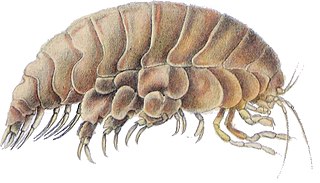
Eurythenes gryllus is a relatively large species of amphipod found worldwide in cold, deep oceans. This widespread and often common species is benthic and lives at depths of 550–7,800 m (1,800–25,600 ft).




















